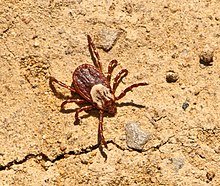Dermacentor
| Dermacentor | |
|---|---|
 |
|
| Dermacentor occidentalis | |
| Scientific classification | |
| Kingdom: | Animalia |
| Phylum: | Arthropoda |
| Class: | Arachnida |
| Subclass: | Acari |
| Superorder: | Parasitiformes |
| Order: | Ixodida |
| Family: | Ixodidae |
| Genus: |
Dermacentor Koch, 1844 |
| Type species | |
|
Dermacentor reticulatus (Fabricius, 1794) |
|
Dermacentor, also known as the American Levi tick, is a genus of ticks in the family Ixodidae, the hard ticks. The genus has a cosmopolitan distribution, with native species on all continents except Australia. Most occur in the Nearctic ecozone.
Hosts of Dermacentor ticks include many large and small mammals, including horses, deer, cattle, lagomorphs, peccaries, porcupines, tapirs, desert bighorn sheep, and humans. The American dog tick (D. variabilis) is a member of the genus.
Dermacentor are vectors of many pathogens, including Rickettsia rickettsii, which causes the disease Rocky Mountain spotted fever, Coxiella burnetii, which causes Q fever, Anaplasma marginale, which causes anaplasmosis in cattle, Francisella tularensis, which causes tularemia, Babesia caballi, which causes equine piroplasmosis, and the Flavivirus that causes Powassan encephalitis.Dermacentor ticks inject a neurotoxin that causes tick paralysis.
...
Wikipedia
